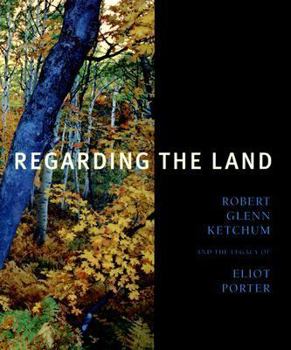Regarding the Land: Robert Glenn Ketchum and the Legacy of Eliot Porter
Select Format
Select Condition 
Book Overview
The work of two great American landscape photographers presented together for the first time-revealing an artistic progression from one generation to the next. 88 colour and duotone reproductions of... This description may be from another edition of this product.
Format:Hardcover
Language:English
ISBN:0883601001
ISBN13:9780883601006
Release Date:January 2006
Publisher:Amon Carter Museum
Length:111 Pages
Weight:2.58 lbs.
Dimensions:0.7" x 10.4" x 12.2"
Customer Reviews
1 rating
Stunning, simply stunning; splendid and challenging
Published by Thriftbooks.com User , 18 years ago
First, I can review this book without even cracking its spine (though I have), as I have seen the Porter/Ketchum exhibit at the Amon Carter in Fort Worth, Texas. (I live in suburban Dallas.) Eliot Porter was the country's first color nature photographer. This was when photographers such as Ansel Adams were moving near their peak and color film shooting was considered askance, suitable only for things like fashion magazine slicks. But Porter showed what could be done with color, including building on Adams' work at places like Glen Canyon to jump-start environmentalism into a new era. He was a seminal influence on Glenn Ketchum, who then took his camera to places like the Cuyahoga River south of Cleveland, documenting efforts in the '60s and beyond to bring national parks and other preservation to scenic areas of the East that had already suffered human encroachment and alteration. Ketchum even went beyond that in spots, in some cases juxtaposing stereotypical "Rust Belt" industrial development with land still showing environmental quality. Ketchum then went on to be a leader and pioneer in aerial nature photography. His Arctic and Antarctic shots are simply incredible. His and Porter's photos are displayed in sizes as large as six feet wide at the Carter exhibit; should this show move on the road and come to your area, you must go see it. The essay in the book by John Rohrbach, senior curator of photographs at the Amon Carter, is a definite must-read. (The Carter has one of America's best museum collections of photographs, and works much more with photographic exhibits than the typical art museum.) Rohrbach discusses how Ketchum has built on and moved beyond Porter, as good students of photography can readily determine. This includes working with China's renowned Suzhou Embroidery Research Institute, which has created some difficult and highly creative tapestry reproductions of some of his scenes. (About 8-10 of these tapestries, ranging from display piece size to triptych room screens, are also on display as part of the exhibit. Environmentalists will love to see what both photographers were trying to say about different aspects of preservation and how they were "speaking." Nature photographers will gain new ideas for lighting and perspective angles. Contrary to another reviewer here, neither photographer represents an "all or nothing" version of environmental activism, and in fact, the idea that there is such a thing, while not strictly untrue, is as much a caricature as reality. Indeed, Ketchum's photography on the Cuyahoga River National Recreation Area, before it became a national park, and elsewhere in the northeast, puts the lie to the idea that environmentalists of his generation never included human artifacts or aftereffects in their artistic work, or that they thought the only true environmentalism was environmentalism that totally eradicated all human traces and touches. Ketchum does NOT present "simply preservation and d





